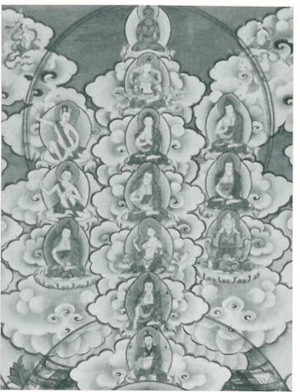The Masters of Meditation and Miracles: The Longchen Nyingthig Lineage of Tibetan Buddhism
Tulku Thondup
Edited by Harold Talbott
Shambhala Publications: Boston, 1996.
383 pp., $35 (cloth).
The Longchen Nyingthig lineage of Tibetan Buddhism is said to have originated with the primordial Buddha Samantabhadra. But the first master of these teachings was Garab Dorje. Born in the Swat Valley in present-day Pakistan, shortly after the death of Shakyamuni Buddha, Garab Dorje was the first human to receive the Dzog Chen (Great Perfect ion) teachings. Longchen means “great vastness,” Nyingthig means the “heart” or “innermost essence,” and the Longchen Nyingthig is the absolute nature of mind, arising as teachings.
 This collection of teachings was revealed as terma [found treasure] by Jigme Lingpa (1730-1798), directly from Longchen Rabjam (1308-1363). In his devotional practice, Jigme Lingpa experienced a series of visions of Longchen Rabjam. Longchen Rabjam, an important master, had condensed all the Nyingthig teachings that came before him, which resulted in revitalizing the ancient Nyingma tradition of Tibetan Buddhism. The lives of the early masters, from Garab Dorje to Guru Padma Sambhava (ninth century), are unique in that they displayed extraordinary attainments and super-human powers. For instance, through the Trekcho and Togyal practices of Dzog Chen, many meditators realized the absolute nature of mind. Through Trekcho, which means “cutting through,” they realized the empty nature of all phenomena, and through Togyal, the luminous nature of mind. Many masters realized what in that tradition is called “the rainbow body of light.” At the time of death, they are said to have dissolved their mortal bodies in to pure light, leaving behind only their hair, fingernails, and toenails. The rainbows are said to be the display of “wisdom light” in the process of dissolving their consciousness in to absolute nature: Buddhahood.
This collection of teachings was revealed as terma [found treasure] by Jigme Lingpa (1730-1798), directly from Longchen Rabjam (1308-1363). In his devotional practice, Jigme Lingpa experienced a series of visions of Longchen Rabjam. Longchen Rabjam, an important master, had condensed all the Nyingthig teachings that came before him, which resulted in revitalizing the ancient Nyingma tradition of Tibetan Buddhism. The lives of the early masters, from Garab Dorje to Guru Padma Sambhava (ninth century), are unique in that they displayed extraordinary attainments and super-human powers. For instance, through the Trekcho and Togyal practices of Dzog Chen, many meditators realized the absolute nature of mind. Through Trekcho, which means “cutting through,” they realized the empty nature of all phenomena, and through Togyal, the luminous nature of mind. Many masters realized what in that tradition is called “the rainbow body of light.” At the time of death, they are said to have dissolved their mortal bodies in to pure light, leaving behind only their hair, fingernails, and toenails. The rainbows are said to be the display of “wisdom light” in the process of dissolving their consciousness in to absolute nature: Buddhahood.
Masters of Meditation contains a wealth of exemplary tales, compiled by Tulku Thondup, an incarnate Tibetan lama and disciple of H.H. Dodrup Chen Rinpoche, the present throne-holder of the Longchen Nyingthig lineage. Among my favorite legends is the story of Dola Jigme Kalzang who lived during the nineteenth century, the main disciple of the first Dodrup Chen Rinpoche. At the end of his life, Jigme Kalzang was walking alone on a street in China, when he saw a thief about to be burned alive. Seated upon a copper horse that was heated from inside by a fire, the thief was screaming for help. Feeling compassion for the man’s plight, Dola Jigme Kalzang told the authorities that the prisoner was not guilty and that he himself was the actual thief. By the time his disciples found him, it was too late. He had been executed in the thief’s place, giving his life in ransom for an unknown suffering person in an unknown street.
The most famous master of miracles in the Tibetan tantric Buddhist tradition of the last few centuries was Do Khyentse Yeshe Dorje (1800-1866), who demonstrated the power of his enlightened mind by performing such acts as vanishing for days to pure lands, bringing murdered beings back to life, and leaving imprints of his body on numerous rocks as if on mud.
The best story, however, is in some respects the plainest and least extraordinary of all. Nyoshul Lungtok (1829-1901), a student of the illustrious Dzog Chen master, Patrul Rin poche, was completely accomplished in Trekcho and Thogal practices, but had not yet grasped the true nature of mind.
Every day at dusk, Paltrul would do a meditation session on the training on Namkha Sumtruk, a practice called “eating the sky”, stretched out on his back on a new woolen carpet on a piece of grassy field the size of his body. One evening, while Paltrul was lying there as usual, he asked Lungtok, “Lungche [Dear Lung]! Did you say that you do not know the true nature of mind?”
Lungtok answered, “Yes, sir; I don’t.” Paltrul said, “Oh, there is nothing not to know. Come here.” So Lungtok went to him. Paltrul said, “Lie down, as I’m lying, and look at the sky.” As Lungtok did so, the conversation went as follows:
“Do you see the stars in the sky?”
“Yes.”
“Do you hear the dogs barking in Dzog Chen Monastery (at afar distance)?”
“Yes.”
“Well, that is meditation.”
At that moment, Lungtok attained confidence in the realization itself. He had been liberated from the conceptual fetters of “it is” or “it is not.” He had realized the primordial wisdom, the naked union of emptiness and intrinsic awareness, the Buddha Mind.
Though it hardly matches the miraculous tales related elsewhere in Masters of Meditation and Miracles, this simple story illustrates perhaps better than any other in the volume how the guru ultimately shows his disciple the true nature of his own mind. And this, after all, is what lineage is all about.